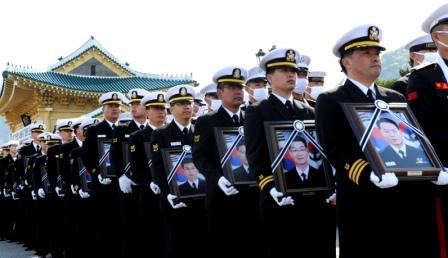Rough Diplomatic Waters on Korean Peninsula
More on:

The March 26 sinking of a South Korean corvette, the Cheonan, while on patrol in disputed waters near one of South Korea’s northernmost islands has thrown the country into a state of high anxiety. No wonder. South Koreans strongly suspect a North Korean torpedo was responsible for the explosion that killed forty-six crew members.
Since the incident, the administration of President Lee Myung-bak has been consumed with efforts to rescue missing crew members, assembling an international team to investigate the cause of the sinking and mounting a remarkably rapid salvage operation to bring the two main pieces of the ship to the surface. The administration also needed to respond to 24/7 media coverage of all aspects of the case and testify to the South Korean National Assembly, console victims’ families, and mourn and honor the dead.
In addition to the difficulties of handling the episode’s immediate aftermath, the Cheonan sinking poses tough policy choices for the Lee administration on three fronts. The first is how to respond to North Korea, given South Korea’s strong, though unconfirmed, suspicions. Other issues include how to fix the South Korean government’s crisis-management capacity and pursue reforms in defense policy and in the defense ministry, and how to manage domestic political fallout in the run-up to South Korea’s June local elections. Some analysts have suggested the establishment of a commission similar to the U.S. task force that made policy recommendations to the U.S. government following 9/11.
The biggest challenge in mounting an effective response, however, is that as long as the case is circumstantial, there will be a surfeit of conspiracy theories, but no solid basis upon which to take retaliatory action.
Visual evidence from the salvaged pieces of the ship led the investigation team to conclude on April 25 that an underwater "non-contact external explosion" caused the corvette to sink, but it’s unlikely there will be definitive proof it came from a North Korean torpedo. North Korea has denied responsibility for the incident, but South Korean media are full of speculation regarding heightened training of North Korean special forces in advance of the incident and special promotions for generals involved in overseeing the North’s forces.
The Lee administration’s response has been measured, despite public anger, as evidenced by its decisions to internationalize the investigation and to pursue any response with the United States. The South Korean foreign minister suggested taking the issue to the UN Security Council as part of a strategy of bringing international pressure to bear rather than going it alone. South Korea may adopt toughened rules of engagement near the DMZ and ban North Korean ships from traversing South Korea’s exclusive economic zone. The biggest challenge in mounting an effective response, however, is that as long as the case is circumstantial, there will be a surfeit of conspiracy theories, but no solid basis upon which to take retaliatory action.
North Korea has taken aggressive measures in recent days to confiscate the property of South Korean companies at Mount Kumgang, which has been dormant for almost two years after tours were shut down following the shooting of a South Korean female tourist in July 2008. Further retaliatory measures by either side might involve the suspension of operations at the Kaesong Industrial Complex, which would cost North Korea $30-$40 million in payments, while South Korean companies would seek relief from the South Korean government.
The Lee administration is more likely to scrutinize every aspect of inter-Korean relations with the North with a view to making life harder for North Korea’s leaders without inviting further escalation.
Given North Korea’s gradual slide towards irrelevance on the South Korean policy agenda and an accompanying squeeze in inter-Korean economic relations under President Lee, North Korea might be attracted by the prospect of a deniable, containable method by which to send the signal that Pyongyang’s leadership should not be taken for granted. Perversely, such an event might serve as a reminder that North Korea is dangerous, and that South Korea can keep the North calm--for a price. But the Lee administration is more likely to scrutinize every aspect of inter-Korean relations with the North with a view to making life harder for North Korea’s leaders without inviting further escalation.
The Cheonan incident will have a significant effect on the direction of South Korea’s defense ministry. South Korea’s overall defense strategy, spending choices, command and control mechanisms, and the efficiency and capability of the defense ministry have all come under increasing public scrutiny. Calls for the delay in planned revision of operational control arrangements and disbanding of the Combined Forces Command have been a focal point of discussion thus far, but the debate should also consider more fundamental questions regarding the current and future structure of South Korea’s armed forces and the level and types of investment necessary to achieve effective self-defense.
Finally, the Cheonan tragedy has distracted South Korean public attention from June local elections that were likely to result in major losses for the ruling Grand National Party. The Lee administration may benefit electorally from the distraction unless the South Korean public feels that the investigation is being manipulated for political purposes; at the same time, the Lee administration’s handling of the Cheonan incident will contribute to defining the Lee administration’s legacy.
More on:
 Online Store
Online Store
